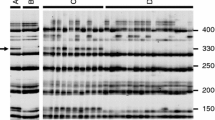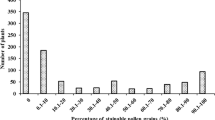Abstract
Key message
In Chinese cabbage, there are two Rf loci for pol CMS and one of them was mapped to a 12.6-kb region containing a potential candidate gene encoding PPR protein.
Abstract
In Chinese cabbage (Brassica rapa), polima cytoplasmic male sterility (pol CMS) is an important CMS type and is widely used for hybrid breeding. By extensive test crossing in Chinese cabbage, four restorer lines (92s105, 01s325, 00s109, and 88s148) for pol CMS were screened. By analyzing the allelism of the four restorer lines, it was found that 92s105, 01s325, and 00s109 had the same “restorers of fertility” (Rf) locus (designated as BrRfp1), but 88s148 had a different Rf locus (designated as BrRfp2). For fine mapping the BrRfp1 locus of 92s105, a BC1F1 population with 487 individuals and a BC1F2 population with 2485 individuals were successively constructed. Using simple sequence repeat (SSR) markers developed from Brassica rapa reference genome and InDel markers derived from whole-genome resequencing data of 94c9 and 92s105, BrRfp1 was mapped to a 12.6-kb region containing a potential candidate gene encoding pentatricopeptide repeat-containing protein. Based on the nucleotide polymorphisms of the candidate gene sequence between the restoring and nonrestoring alleles, a co-segregating marker SC718 was developed, which would be helpful for hybrid breeding by marker-assisted screening and for detecting new restorer lines.




Similar content being viewed by others
References
Arnal N, Quadrado M, Simon M et al (2014) A restorer-of-fertility like pentatricopeptide repeat gene directs ribonucleolytic processing within the coding sequence of rps3-rpl16 and orf240a mitochondrial transcripts in Arabidipsis thaliana. Plant J 78:134–145
Barkan A, Small I (2014) Pentatricopeptide repeat proteins in plants. Annu Rev Plant Biol 65:415–442
Bentolila S, Alfonso AA, Hanson MR (2002) A pentatricopeptide repeat-containing gene restores fertility to cytoplasmic male-sterile plants. Proc Natl Acad Sci USA 99:10887–10892
Brown GG, Formanová N, Jin H et al (2003) The radish Rfo restorer gene of Ogura cytoplasmic male sterility encodes a protein with multiple pentatricopeptide repeats. Plant J 35:262–272
Chase CD (2007) Cytoplasmic male sterility: a window to the world of plant mitochondrial-nuclear interactions. Trends Genet 23:81–90
Chen L, Liu Y (2014) Male sterility and fertility restoration in crops. Annu Rev Plant Biol 65:579–606
Cheng S, Gutmann B, Zhong X et al (2016) Redefining the structural motifs that determine RNA binding and RNA editing by pentatricopeptide repeat proteins in land plants. Plant J 85:532–547
Cui X, Wise RP, Schnable PS (1996) The rf2 nuclear restorer gene of male-sterile T-cytoplasm maize. Science 272:1334–1336
Desloire S, Gherbi H, Laloui W et al (2003) Identification of the fertility restoration locus, Rfo, in radish, as a member of the pentatricopeptide-repeat protein family. EMBO Rep 4:588–594
Dill CL, Wise RP, Schnable PS (1997) Rf8 and Rf* mediate unique T-urf13-transcript accumulation, revealing a conserved motif associated with RNA processing and restoration of pollen fertility in T-cytoplasm maize. Genetics 147:1367–1379
Fu TD (1981) Production and research of rapeseed in the People’s Republic of China. Eucarpia Cruciferae Newsl 6:6–7
Fu T, Yang X, Yang G (1989) Development and studies on polima cytoplasmic male sterile ‘three lines’ in Brassica napus L. J Huazhong Agric Univ 8:201–207
Fujii S, Toriyam K (2008) Genome barriers between nuclei and mitochondria exemplified by cytoplasmic male sterility. Plant Cell Physiol 49:1484–1494
Fujii S, Toriyam K (2009) Suppressed expression of retrograde-regulated male sterility restores pollen fertility in cytoplasmic male sterile rice plant. Proc Natl Acad Sci USA 106:9513–9518
Fujii S, Bond CS, Small ID (2011) Selection patterns on restorer-like genes reveal a conflict between nuclear and mitochondrial genomes throughout angiosperm evolution. Proc Natl Acad Sci USA 108:1723–1728
Hanson MR, Bentolila S (2004) Interactions of mitochondrial and nuclear genes that affect male gametophyte development. Plant Cell 16:S154–S169
Hu J, Wang K, Huang W et al (2012) The rice pentatricopeptide repeat protein RF5 restores fertility in Hong-Lian cytoplasmic male-sterile lines via a complex with the glycine-rich protein GRP162. Plant Cell 24:109–122
Itabashi E, Iwato N, Fujii S et al (2011) The fertility restorer gene, Rf2, for Lead Rice-type cytoplasmic male sterility of rice encodes a mitochondrial glycine-rich protein. Plant J 65:359–367
Jean M, Brown GG, Landry BS (1997) Genetic mapping of nuclear fertility in canola (Brassica napus L.) using DNA markers. Ther Appl Genet 95:321–328
Jordan DR, Mace ES, Henzell RG et al (2010) Molecular mapping and candidate gene identification of the Rf2 gene for pollen fertility restoration in sorghum [Sorghum bicolor (L.) Moench]. Theor Appl Genet 120:1279–1287
Ke G, Song Y (1989) Breeding of alloplasmic male sterile line in Chinese cabbage (Brassica campestris L. ssp. pekinensis (Lour) olsson) and its application. Shaanxi J Agric Sci 3:9–11
Ke G, Zhang L (1993) Study on the relartionship of restoration and maintenance of alloplasmic male sterile in Chinese cabbage. Acta Agricuturae Boreali-ccidentalis Sinica 2:15–20
Ke G, Zhao Z, Song Y et al (1992) Breeding of alloplasmic male sterile line CMS3411-7 in Chinese cabbage (Brassica campestris L. ssp. pekinensis (Lour) olsson) and its application. Acta Horticulturae Sinica 19:333–340
Kitazaki K, Arakawa T, Matsunaga M et al (2015) Post-translational mechanisms are associated with fertility restoration of cytoplasmic male sterility in sugar beet (Beta vulgaris). Plant J 83:290–299
Klein RR, Klein PE, Mullet JE et al (2005) Fertility restorer locus Rf1 of sorghum (Sorghum bicolor L.) encodes a pentatricopeptide repeat protein not present in the collinear region of rice chromosome 12. Theor Appl Genet 111:994–1012
Koizuka N, Imai R, Fujimoto H et al (2003) Genetic characterization of a pentatricopeptide repeat protein gene, orf687, that restores fertility in the cytoplasmic male-sterile Kosena radish. Plant J 34:407–415
Komori T, Ohta S, Murai N et al (2004) Map-based cloning of a fertility restorer gene, Rf-1, in rice (Oryza sativa L.). Plant J 37:312–325
Li Q, Wan JM (2005) SSRHunter: development of a local searching software for SSR sites. Hereditas 27:808–810
Liu XQ, Xu X, Tan YP et al (2004) Inheritance and molecular mapping of two fertility-restoring loci for Honglian gametophytic cytoplasmic male sterility in rice (Oryza sativa L.) Mol Gen. Genomics 271:586–594
Liu Z, Liu P, Long F et al (2012) Fine mapping and candidate gene analysis of the nuclear restorer gene Rfp for pol CMS in rapeseed (Brassica napus L.). Theor Appl Genet 125:773–779
Liu Z, Yang Z, Wang X et al (2016) A mitochondria-targeted PPR protein restores pol cytoplasmic male sterility by reducing orf224 transcript levels in oilseed rape. Mol Plant 9:1082–1084
Luo D, Xu H, Liu Z et al (2013) A detrimental mitochondrial-nuclear interaction causes cytoplasmic male sterility in rice. Nat Genet 45:573–577
Nagaharu U (1935) Genome analysis in Brassica with special reference to the experimental formation of B. napus and peculiar mode of fertilization. Jpn J Bot 7:389–452
Porebski S, Bailey LG, Baum BR (1997) Modification of a CTAB DNA extraction protocol for plants containing high polysaccharide and polyphenol components. Plant Mol Biol Report 15:8–15
Tang H, Luo D, Zhou D et al (2014) The rice restorer Rf4 for wild-abortive cytoplasmic male sterility encodes a mitochondrial-localized PPR protein that functions in reduction of WA352 transcripts. Mol Plant 7:1497–1500
Uyttewaal M, Arnal N, Quadrado M et al (2008) Characterization of Raphanus sativus pentatricopeptide repeat proteins encoded by the fertility restorer locus for Ogura cytoplasmic male sterility. Plant Cell 20:3331–3345
Wang Z, Zou Y, Li X et al (2006) Cytoplasmic male sterility of rice with Boro II cytoplasm is caused by a cytotoxic peptide and is restored by two related PPR motif genes via distinct modes of mRNA silencing. Plant Cell 18:676–687
Wang X, Wang H, Wang J et al (2011) The genome of the mesopolyploid crop species Brassica rapa. Nat Genet 43:1035–1039
Wang ZW, Wang C, Gao L et al (2013) Heterozygous alleles restore male fertility to cytoplasmic male-sterile radish (Raphanus sativus L.): a case of overdominance. J Exp Bot 64:2041–2048
Wise RP, Gobelman-Werner K, Pei D et al (1999) Mitochondrial transcript processing and restoration of male fertility in T-cytoplasm maize. J Hered 90:380–385
Xu X, Sun X, Zhang Y et al (2014) Identification of AFLP and SSR markers linked with the male fertility restorer gene of CMS 06J45 in heading Chinese cabbage (Brassica rapa L. ssp. pekinensis). Plant Breed 133:615–619
Yang G, Fu T (1991) A preliminary study on the restoring-maintaining relationship in rapeseed (Brassica napus and Brassica campestris). Acta Agronomica Sinica 17:151–156
Yin P, Li Q, Yan C et al (2013) Structural basis for the modular recognition of single-stranded RNA by PPR proteins. Nature 504:168–171
Zhang L, Hao D (2001) Investigation on the sterility changeover of male sterility line CMS7311 in heading Chinese cabbage. Acta Botanica Sinica 43:1123–1128
Zhang L, Ke G (1994) The genetic law and restoration of alloplasmic male sterile in Chinese cabbage (Brassica campestris L. ssp. pekinensis (Lour) olsson). Acta Agricuturae Boreali-ccidentalis Sinica 3:45–50
Acknowledgements
This work was supported by grants from The National Key Research and Development Program of China (2016YFD0101701) and the National Science and Technology Support Program of China (2014BAD01B0802).
Author information
Authors and Affiliations
Corresponding author
Ethics declarations
Conflict of interest
The authors declare that they have no conflict of interest.
Ethical standards
The authors declare that this study complies with the current laws of the countries in which the experiments were performed.
Additional information
Communicated by C. F. Quiros.
Electronic supplementary material
Below is the link to the electronic supplementary material.
Rights and permissions
About this article
Cite this article
Zhang, H., Wu, J., Dai, Z. et al. Allelism analysis of BrRfp locus in different restorer lines and map-based cloning of a fertility restorer gene, BrRfp1, for pol CMS in Chinese cabbage (Brassica rapa L.). Theor Appl Genet 130, 539–547 (2017). https://doi.org/10.1007/s00122-016-2833-9
Received:
Accepted:
Published:
Issue Date:
DOI: https://doi.org/10.1007/s00122-016-2833-9




